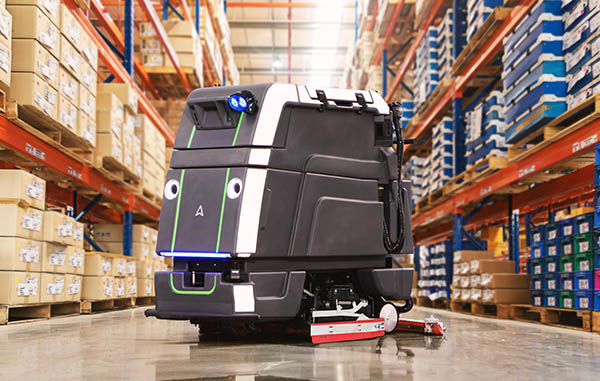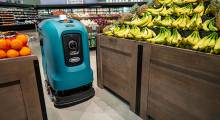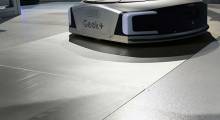The need to move materials, clean surfaces, and collect data in factories, warehouses, and other facilities has only grown. Despite fears of robots replacing workers who are scarce in many industries, most of the automation spreading today is meant to improve efficiency and safety. Avidbots Corp. is an example of a robotics supplier rising to the challenge with multifunction systems.
The Kitchener, Ontario-based company has designed, manufactured, sold, and serviced autonomous floor-cleaning robots since 2014. Its Neo 2 system combines artificial intelligence, cameras, sensors, and software to clean and provide data on where it cleaned.
Neo 2 users can create a custom cleaning plan, and the robot then monitors, measures, and reports on that cleaning, explained Pablo Molina, chief technology officer of Avidbots. He spoke with Robotics 24/7 about the autonomous mobile robot (AMR) market, where automation can be most useful, and his company's plans.
Avidbots addresses pain points
How has the growth of omnichannel retail since the COVID-19 pandemic affected demand for Avidbots' robots?
Molina: There has been growth in demand for our products. People saw robots being able to help in difficult times, and trust in robotics has improved.
CEOs from large incumbent cleaning companies expect 20% to 30% of sales in cleaning equipment to be fully autonomous by 2025. We're executing in engineering and sales.
With labor shortages and capital concerns, how do you address industry needs?
Molina: For all automation, including cleaning robots, we shouldn't forget there's an ROI [return on investment] play. The other benefits are becoming important for business owners.
Absenteeism is a big issue in cleaning, and turnover averages 300%, or about every three months. Robotics brings new levels of accountability and reporting, so the level of service can be higher.
We also clean in warehousing, where forklift operators often have to stop to jump on manual cleaning machines. They're getting paid quite a bit to do that, and they don't like it.
How have facilities operators and staffers reacted to Neo 2? What are some examples of customer expectations and training requirements?
Molina: The majority of deployments we do are received positively. People like to give the robots nicknames. We work hard not to change how facilities operate.
First, we make sure we understand the needs of the customer and that they know how to use the robots and our command center. Not every cleaning robotics company does this.
We send a team to each site for training, deployment, and customer success. Deployment takes between two and five days, and it may take a little bit longer for some larger places.
Do robots actually help with recruitment and retention?
Molina: You may be surprised to learn that in 95% of our deployments, people don’t lose their jobs. There's a lot of cleaning that needs to be done, and people often end up cutting corners.
When you ask facilities managers how clean their places are, most will say they wish they could do more. Our robot gives them the visibility to increase service levels and provide better-quality service.
Robots are time-saving tools, freeing humans to do higher-level tasks. Ten to 20 years from now, the penetration will be 50% to 60%, and buildings will be better environments to be in.
Multifunction robots mature
How does Avidbots Autonomy manage machines and people for “multifunction, intervention-free operation”?
Molina: The majority of times that robots get stuck, it's sensor data from shiny obstacles or angles that give “noise.” A lot is easy to correct remotely.
In really tight spaces where robots can't turn, like when boxes are left in an aisle during restocking in retail, we're working with customers to explain to them what they can do to help with interventions.
We provide 24/7 support, and it takes only 10 to 30 seconds to connect with a technician. We're working on minimizing that time, but a lot of data is involved, and the customer interface is important.
Are you seeing demand grow across commercial, industrial, and retail sectors?
Molina: Retailers are interesting because they're working to improve the experience for their customers and are under threat from e-commerce and delivery services.
We have some robots in a Walmart supercenter near our headquarters that run in the mornings. I'm excited about the future of what robots can do.
Most robots can do only one or two things well. How mature are multifunction systems, which promise to save time and money?
Molina: Multifunction robots are already here, such as Tennant and Brain Corp's shelf-scanning and floor-cleaning model. We have a disinfection add-on.
There's no doubt that's where the future is going—robots are getting smarter, and you can do more at the edge. We'll be seeing a lot more startups offering concierge robots, taxi robots, and shelf-scanning systems.
On the flip side, specialized robots from multiple vendors could soon coexist in the same spaces. Are you following interoperability standards efforts?
Molina: Functional safety is very important, so we're involved in every committee for functional safety. We want robots to be seen as companions or tools.
We clean many different types of locations, like airports and retail stores. The need for interoperability is higher in manufacturing and warehouses. We don't run into other robots in a lot of our other verticals.
It's still early, and there is no conclusive standards effort yet. Different groups have different requirements—for example, German automotive or in a very busy hospital. We have yet to see one that covers everybody.
I hope they'll eventually go to the ISO [International Organization for Standards], as MassRobotics is doing. With an international body, you can have more open discussion. Right now, there are many efforts with a few people in pockets.
Funding, partnerships, and industry challenges
Avidbots recently raised $70 million in Series C funding. How is its market expansion going?
Molina: We'll soon expand our product portfolio and add-ons, and we're also expanding to new geographic areas.
We're at a beautiful inflection point for robotics. We're still at the beginning, but be aware that with commoditization lowering the costs of robots, there will be explosive growth. It opens up so many more avenues.
Avidbots has partnered with PTC Onshape to cut development time for your robots. How has it resulted in 50% savings?
Molina: It been a very helpful tool to connect mechanical engineering work. PTC has done a good job of unifying the development world with supply chain and change tracking.
While the resurgence of U.S. manufacturing could add up to 1.5 million jobs, according to McKinsey, 64% of manufacturers have difficulty finding candidates with specific knowledge or skills, reported PTC. Design engineers spend up to a third of their time on non-design tasks.
Avidbots' file-based CAD system slowed communications, so we switched to Onshape, which provides a “single source of truth” for product designs across the organization through real-time data management.
Looking ahead, what is your company working on?
Molina: Avidbots is building a portfolio of products of different sizes and types. For example, since we have a focus on warehousing, we're working on some hardware improvements for facilities with a lot of debris.
We're figuring out how to correct for things like pieces of wood and to make the experience better. We'll solve problems with deep learning, and I expect we'll add more intelligence to our robots in the next two quarters.
About the Author
Follow Robotics 24/7 on Linkedin
Article topics
Email Sign Up


















